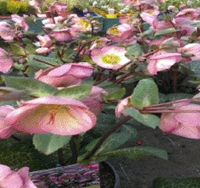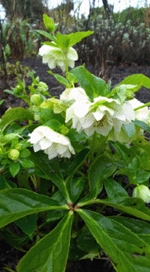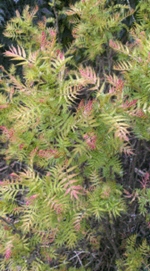Hellebores are the only flowering perennial that gives real impact on the sales bench at the early part of the year. Helleborus niger, the Christmas Rose, starts things off in January, though there are not alot of customers around to get large sale volumes, still it’s nice to have something in flower. But the new hybrids are what are really exciting in the hellebore world. These tend to have Helleborus niger as one parent and Helleborus lividus sometimes together with the more known Helleborus argutifolius (corsicus). Tissue culture has made these varieties available in quantity. Before this, traditional methods of division were used which were painfully slow and resulting plants, when available, were expensive.
A man called Eric Smith was one of the first to do these crosses so we have the Eric Smith hybrids, latinised as Helleborus x ericsmithii. I suppose it could have been worse, his name could have been Joe Bloggs. What makes these varieties so good is that they are compact, have good evergreen foliage and some such as Winter Moonbeam being particularly good in that department, with lovely netted leaves. As sterile plants they have longer flowering periods than fertile ones – good for the seller and the gardener.

A clump of Helleborus Bob’s Best happy in our north facing border
One of the most popular at the moment is Bob’s Best, with white flowers that fade nicely to pink. It has started to flower for me in February and should go on till May. There are lots of others, with more coming all the time. I got a few darkish ones last month to try out. They were expensive so I decided to see what I could sell at the high price and plant out the rest. They actually sold well, at what I thought was an outrageous price. I won’t have many left for my garden. One I particularly liked was called Penny’s Pink, which has a yellowish centre, pale further out, than purple. I think garden centres should push them a bit more.

Helleborus Penny’s Pink costs a lot of pennies
New varieties of Helleborus niger are also benefiting from tissue culture. Some are startlingly white and could front a DAZ washing powder commercial.
Helleborus orientalis has had its name changed to the more nondescript, Helleborus x hybridus, but that’s botanists for you. It is harder to present on the sales bench with its longer, more spread out flower, and with a shorter flowering time. The double forms actually sold well this spring. Some people turn up their noses at double flowers, saying that they lack refinement -the flowers that is. I planted some out and I am surprised at how well they looked. The flowers are not fully double at they retain the capacity to set seed. In fact they tend to be seed raised, so there is always a bit of pot luck when bought in bud.

White double Hellebore looking very elegant
Hellebores like good improved clay and do well in shade. They hate badly drained mucky soil, growing poorly and susceptible to those black leaf diseases. I have some self sown seedlings of Helleborus x hybridus growing in heavy shade for years and they are always clean as a whistle.

Sorbaria sorbifolia SEM
PS A plant that has little problem with heavy unimproved clay is Sorbaria sorbifolia SEM. It is protected by plant breeders rights, and rightly so. This is a good garden plant, and also a good garden centre plant – one doesn’t always imply the other. It is a member of the rose family and reminiscent of a rubus without the thorns. Though deciduous, it’s out of leaf for such a short period, it could be regarded as evergreen. It is grown for its golden foliage, with red and pink hues, particularly good when young. Its one drawback is that it suckers , but not enough to make it uncontrollable. It should make a good general landscape plant, suitable for the heavy indifferent soils which are often the lot of the commercial landscaper.

“John has a diploma in Horticulture from the National Botanic Gardens, a degree in Botany from Trinity College and a diploma in Tree Craftsmanship from Merrist Wood College in Surrey. He worked in the nurseries of north Germany where he got his interest in craft gardening. He is the owner of Ratoath Garden Centre, whose slogan “mad about plants”, is not far from the truth!”
Source: HortiTrends News Room





